“I’m just telling you that I need poetry, that it is not an indulgence or a luxury for me, but the best antidote to mere despair that I can find at the moment, that it helps me to feel un-alone even way down deep where the loneliness would otherwise be absolute. I realize that I’m preaching to the choir here, but I need you to keep singing, so.” -John Green in Poetry Magazine, June 2020 When Lindsay Illich and Melissa Alter Smith, authors of Teach Living Poets, brought their poetic knowledge to the North Dakota Council of Teachers of English 2022 Summer Conference, they shared the above quote from John Green. “I realize that I’m preaching to the choir here, but I need you to keep singing, so.” - John Green At NDCTE, we are the choir of North Dakota’s English teachers. Sometimes that choir is more metaphorical—sometimes it is quite literal. And if we are literally the choir, we can be found singing parodies that have been inspired by the conference gathering. Sometimes the parodies are written prior to the gathering and sometimes from the content that was shared.
Thus, without further ado, here is a list of the parodies (complete with links to the lyrics) that “the choir” has both written and sung: 1. “Let it Go” parody: This parody was written and brought to life at the 2016 NDCTE Conference by Angela Hase and Erika Dyk. They were presenting a session entitled "A Space to Heal," which addressed the topic of teacher grief. The song was sung after participants had written what they needed to let go of on dissolving paper and “let it go” by placing the paper in bowls of water on the table. 2. “We Can Open the Doors": This parody of "A Whole New World" was written with the inspiration of Donalyn Miller’s keynote address in 2018. The words were written Angela Hase and Erika Dyk. Lisa Gusewelle inspired the song idea; the song was dedicated to Bridget Ryberg. The song was shared at the end of the conference. 3. Imagine. Make. Believe. Parodies: These parodies were written by Lisa Quintus for the 2021 Conference, which had the theme of Imagine. Make. Believe. Lisa Quintus shared her theatrical background (and flair) by providing costuming to go with these parodies. *Imagine: Donna Davidson (on her guitar) and Erika Dyk (on her ukulele) brought this parody of "Imagine" to life, complete with some costuming. *Make: This is a parody of Green Eggs and Ham. Lisa Quintus and Erika Dyk recited the poem, complete with whimsical costuming. *Believe: This parody of "Don't Stop Believin'" was sung as a sing-a-long at the end of the conference. 4. "Ready to Thrive": This parody of “Part of Your World” was written by Angela Hase, Erika Dyk, and Sherry Lind. Angela Hase and Erika Dyk led the song acapella (Erika’s attempt to retrieve her ukulele was thwarted by a most fierce storm) to start the last afternoon of the 2023 NDCTE Summer Conference. Songs have been sung. Songs will continue to be sung. So, come sing with us. We gather on the Facebook group "NDCTE Connects" asynchronously. We gather at our annual conference synchronously. We would love to have your voice join our metaphorical and sometimes literal choir. Share your voice at the October 25, 2024, NDCTE Conference by submitting a proposal to present. We would love to hear your voice, and maybe you will help write the next NDCTE parody!
0 Comments
First, the community poem:
A Glimpse of North Dakota, a Random and Incomplete List Compiled by NDCTE members, Aug. 1, 2023 1. Walking into the chilly ballroom in the heat of July: blinded by the overhead lights, I cannot look above the horizon in fear of white spots creeping in the periphery, perhaps speeding me to early sight loss. When the light settles, people take shape: speech and debate coaches from teacher-me long ago forgotten, a colleague from year-one-me, friends that sing with me and create with me and breathe with me. They all sit around black tables--talking, testifying, talltale-ing--beckoning me in. 2. The ballroom at the Baymont Inn where I witnessed the creation of a strong friendship– laughter, vacations, banter, separation– From then on, I knew the power of theater. Gentle waves whisper a rhythmic reassurance the universe is greater than any weight we carried here. 3. Just outside the Baymont, the air changes with a blast of warmth cooling, calming wind while the birds chirp and the cars rush past. Off in the distance, patches of quilt and rolling horizon bring peace in the chaos. 4. I feel warm under the light of a wide open sky. I am wide open. My hair moving in the wind. Cotton blowing in the wind. The noise of cars zooming by. 4. The guys in the truck wave. They ride down the country road, wind pouring into the rolled-down window of a 1974 Ford truck, the back end open. When cars rush by, they whip away the humidity blanketing my body. Sunshine sweeps the sidewalk everywhere you look. 5. The boat dock parking: a meeting place, a parking lot, the God-made-world meets humans. Straight ahead, teenagers listening to music too loud, two cars down, a potential drug deal, one couple on a romantic walk, starting their journey, another ending theirs. 6. The lights as seen from North Hill: streetlights cascading the river of main street, flecks of foam cast from the river’s flow. Sitting on the triplex roof, fireflies out in the calm, hot summer air. 7. The road into Cannonball as seen from the Furry Friends rescue van: dogs in the road barking greetings as they band together. 8. Crisp, white farm houses standing like tall ships in full sail gliding over the oceans of undulating wheat. The forever sky stretching over fields of bowing sunflowers; golden light on golden petals. 9. The table is set, the meal prepared– the conversation settles on us– expanding and filling the voids of loneliness and the unknown. For a moment the only thing that exists is us and them, the clicking of the little chihuahua feet on the floor. At grandma and grandpa’s house, where there will be, always, cards and desert. 10. At the edge of the petrified forest, my teenage daughter and her friend sit in a patient protest against the heat and this hike, while my youngest son runs ahead like an antelope. No forest except sparse, fallen trees– once mighty bark and beating sap, root, fiber, green-needled– now distilled, hardened, in ruins. 11. Then and now, wind and wild settling into the North Dakota soil branching into the North Dakota sky. Home and possibility. 12. Since music relies on wind North Dakota is alive with notes dancing in the air, inspiring us, moving beyond us. (Find this poem as a Google doc here.) Second, the process to create the poem: 1. The English teachers of North Dakota created from this writing prompt document, containing the mentor text "Reasons Why I Do Not Wish to Leave Chicago: An Incomplete, Random List" Excerpted from The Book of My Lives (Farrar, Straus and Giroux, $25) by Aleksandar Hemon 2. The English teachers shared on their writing digitally or via paper on the North Dakota map wall. 3. Candace compiled them into the community poem and gave it a title: "A Glimpse of North Dakota, a Random and Incomplete List." She recommends a shared Google document as a place for students to upload their stanzas, rather than the teacher typing it all up. Third, an invitation: Leave your glimpse of North Dakota stanza in a comment, adding to the community poem. May 21, 2022 Hello Teacher Friends, I hope these words find you well as this school year wraps up. This summer, the North Dakota Council of Teachers of English is hosting their annual summer conference July 19-20 in Mandan, North Dakota. One of the keynote speakers is Dave Stuart Jr., and you really should meet him.  Dave Stuart Jr. is the author of the book These 6 Things: How to Focus Your Teaching on What Matters Most (Corwin, 2019) and co-author--with Matthew Johnson and Matthew R. Kay--of a quite new book Answers to Your Biggest Questions About Teaching Middle and High School ELA (Corwin, 2022). Go to his website and his bio reads: DAVE STUART JR. is a husband, father, and high school teacher who writes about education. He reads extensively across the disciplines so that he can create uniquely satisfying professional development experiences for his colleagues around the world. His mission is to encourage and equip educators on the journey to long-term flourishing and professional excellence. Did you catch that term "long-term flourishing"? It is truly the heartbeat behind who Dave Stuart Jr. is and his work. Terri Egan, a North Dakota English teacher and fine arts coach, shares how Dave Stuart Jr. has assisted her on her teacher journey: I have been following Dave’s postings and blogs and YouTube videos (all available at www.davestuartjr.com/archives) and integrating his ideas into my classroom for over eight years. I have used his book These Six Things as a foundation for best-practice teaching, and I had the privilege of attending a summer on-line seminar in 2020 that helped me successfully navigate that year. Dave Stuart provides meaningful, applicable methods of student engagement and motivation with lessons and ideas that you can easily adapt for any classroom. Dave’s methods are rooted in solid pedagogy and science; his on-going classroom experience lends additional credibility to his suggestions. He is an instructional coach who will help you wherever you are at as a teacher right now because he is teaching as a colleague. I hope every pre-service and current educator in ND can join this session - you will leave with something to use! Terri's invitation is a meaningful one, and I join her in inviting you.
Dave Stuart Jr. will be keynoting the second day (July 20) of the conference and also speaking at two breakout sessions. His titles alone help to guide the way to long-term flourishing:
Hope to see you soon, Erika NDCTE President 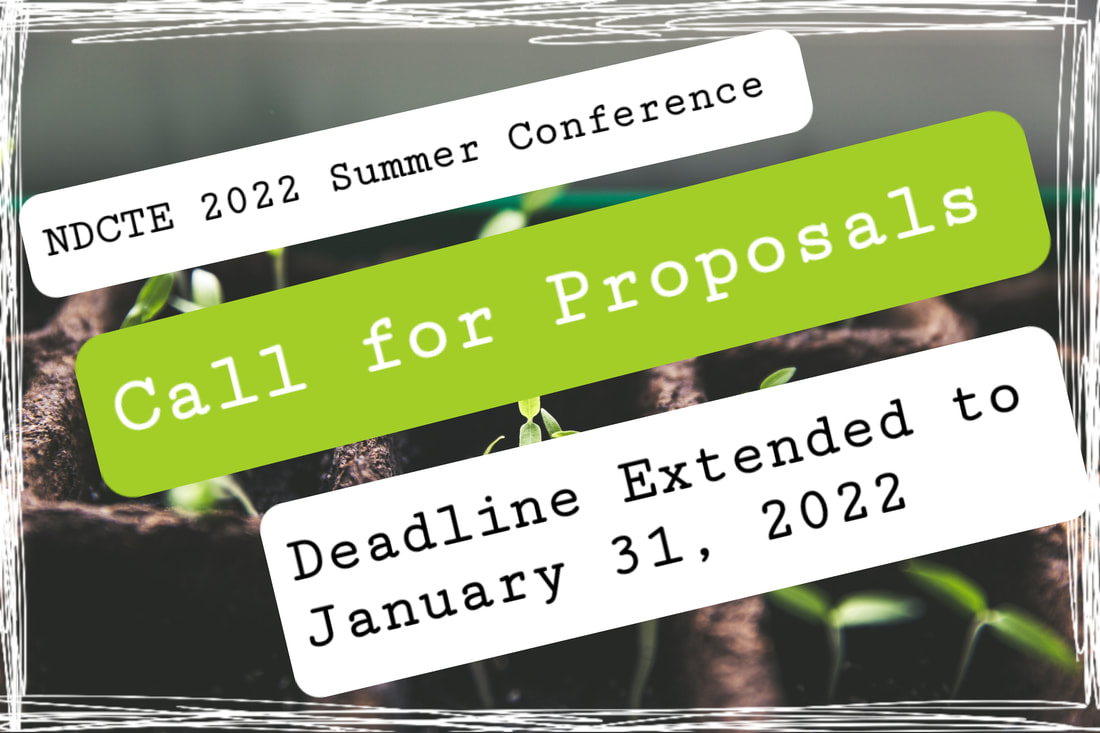 Good news! You still have time to submit your breakout session proposal for the NDCTE 2022 Summer Conference. The conference theme is "Growing Together" and we need you to do just that! The breakout sessions are for one-hour each. We are seeking proposals for best practices in writing, reading, speaking and listening, and language. Submit your idea here: https://forms.gle/D2W9ZvRPCwxBipvf7 P.S. If you need a little extra courage to submit a proposal, here you go! You got this! July 29-30 at the Baymont Inn & Suites in Mandan, ND May 29, 2021 Dear fellow North Dakota English teachers, Congratulations! We have made it through a year to be remembered for so many reasons. It was difficult. It was challenging. It was tech-filled. We normally have to wear many hats, but this year we acquired some new ones, like Google Meet or Zoom hosts! It is time for some relaxation. But before you fully relax, take some time to sign-up for our 2021 in-person NDCTE conference. Why this conference? After this unique school year, this conference will be a chance to connect in-person with your colleagues across the state, gather new information and resources, and have a structured work space and framework to turn your ideas into action.
The theme of our conference is Imagine. Make. Believe. On the first day, our imaginations and minds will be fed from Hugh Hunter, Poetry Out Loud, and C3WP (College, Career, and Community Writers Program). The second day will be about making a plan for our classrooms in the fall. Darcy Bakkegard will be leading "The Educator's 'Innovation' Lab Turning IDEAS into ACTION." So. Imagine coming. Make that happen by registering here. Believe next year will be filled with much growth. Hope to see you there, Erika, wearing her NDCTE President-Elect hat (literally) Vertical Divider
My favorite writing utensils, especially with teaching and grading, are the Paper Mate flair pens. As you can see, I love the variety of colors. They have such ease when writing and always leave a good mark. I like the flair pens because I always like to add flair to what I write, and I love the color variety and feel of the pen on paper. 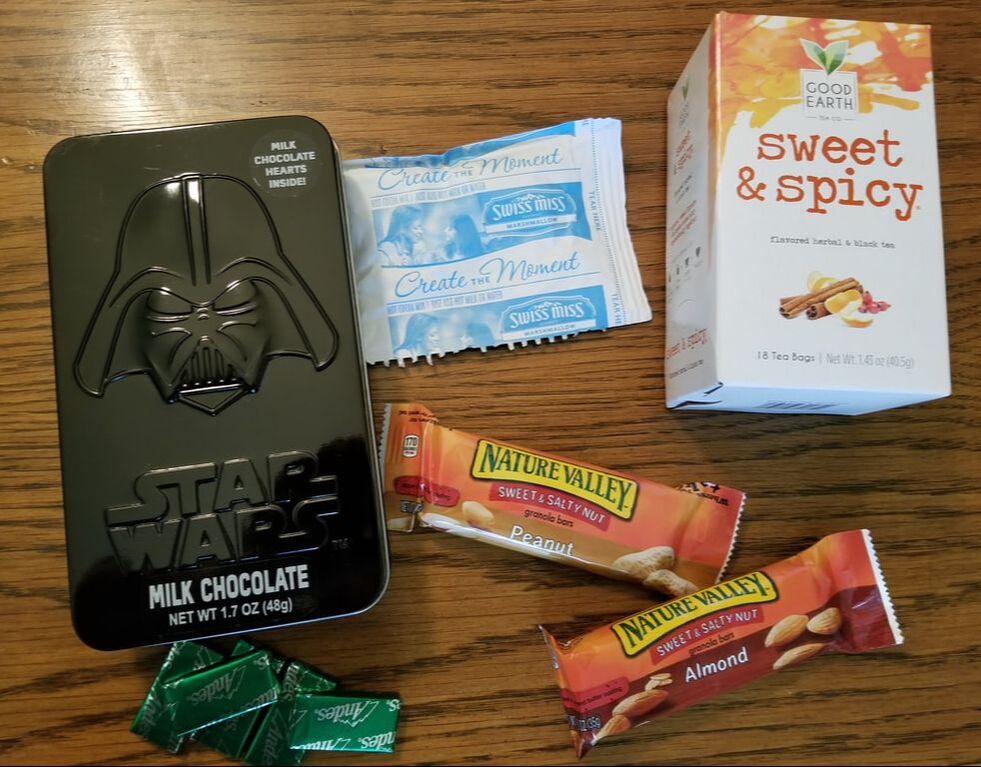 The contents of my snack drawer fall into three categories: breakfast, beverage, and emergency chocolate. First, I keep some sort of granola bar-type-thing because I sometimes get busy or distracted in the morning and forget to eat. I promise, I do check for allergies before I have anything with nuts! Next, since I think coffee is gross, I keep hot chocolate and tea in the desk. That Sweet and Spicy variety is awesome--kind of cinnamony, and it smells amazing. Finally, and arguably most importantly, is the Darth Vader tin of Emergency Chocolate. I usually keep Andes mints in there. Not to promote emotional eating or anything, but it really helps a bad day! Also, the Emergency Chocolate tin prevents me from having to continually raid the candy bowl in my superintendent's office. 🤣
Greetings NDCTE Members,
As Kelsey so eloquently stated, I am here to help you navigate the terrain of this online PD opportunity. This opportunity is available right away. All assignments must be completed by August 14th. We want to reiterate that our intent is to provide an experience that allows for exploring new resources and perspectives and also invites you to discuss and connect with fellow educators of various grade levels across the state, all while being safe and snug at your own workspace. Let's learn! 1. How To Get The Credit We will be using Google Classroom to get the credit. Almost everything you will need to do to obtain the credit is on Google Classroom, including videos, discussions, tech tools, labs, reflections and surveys. You will not need to complete everything on the Google Classroom. It is piecemeal completion until you accrue 15 hours for each credit you seek. 2. Where To Sign-Up Before you can access the Google Classroom, you will need to complete a couple preliminary sign-up steps. The class title is "Weekly Webchats, pt. 4 NDCTE." a. Go to this link to pick an institution listed (NDSU, VCSU, UND, or DSU) b. Email Tim Willenzien to be added to the Google Classroom. 3. What You Need To Do Via Google Classroom Once you have access to the Google Classroom, there are a couple required parts to the PD and other optional parts that you can complete to get the credit hours you need. Tim has composed an excellent welcome post on the Google Classroom. I encourage you to read it thoroughly. Basically, you will be required to introduce yourself, complete two surveys (one pre- and one post-survey), write a 2-page reflection, and complete 15 hours for each credit you seek. The 15 hours can be earned by watching the pre-recorded videos and reflecting on them via the comments section, replying to other comments, experiment with tech tools, or completing a "LAB" assignment. I hope you try out this resource. The NDCTE webchat videos are a part of this course, and so are other video series'. Our board members really explored a diverse range of English topics and opportunities to reach students in meaningful ways. Please let us know if you have any further questions, comments, concerns, thoughts, or ideas concerning signing up to the PD or anything related to it. Be safe; be well. Your NDCTE Board The National Writing Project is a hosting a virtual writing marathon this summer. #WriteAcrossAmerica has already stopped in Wisconsin, Arizona, Mississippi, and Kentucky. This coming week, they stop in North Dakota!
Come and write Tuesday, July 14th from 3:00-4:15 MST/4:00-3:15 CST. For more information about the virtual marathon and to register for the stop (you must register to get the Zoom link), check out: https://lead.nwp.org/writeacrossamerica-a-virtual-writing-marathon/ Bring a friend and come write with us! |
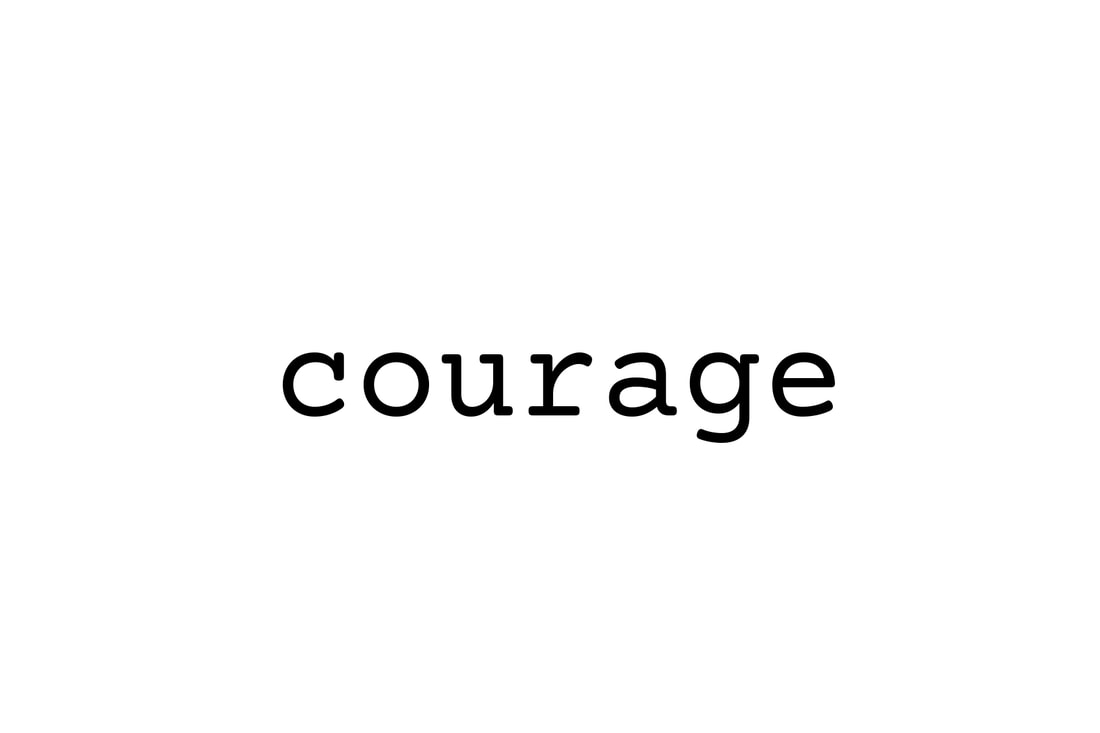
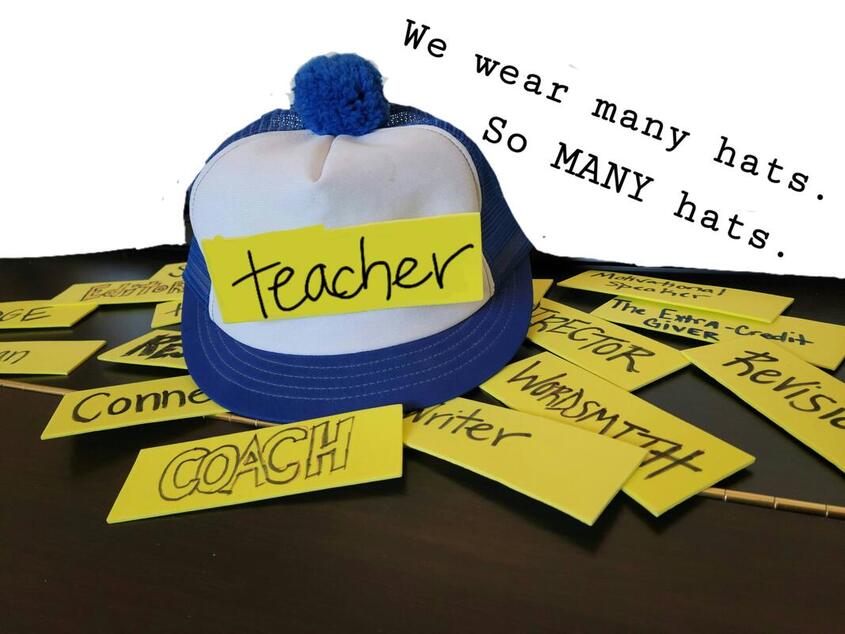
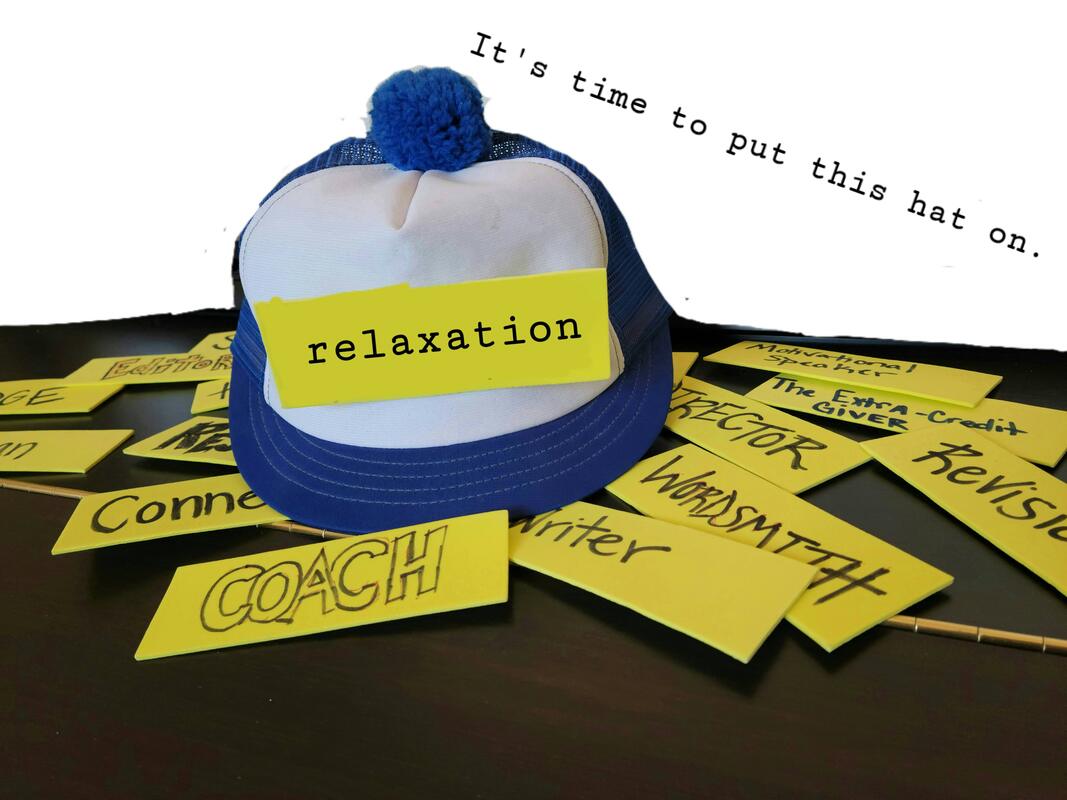

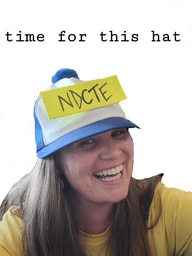
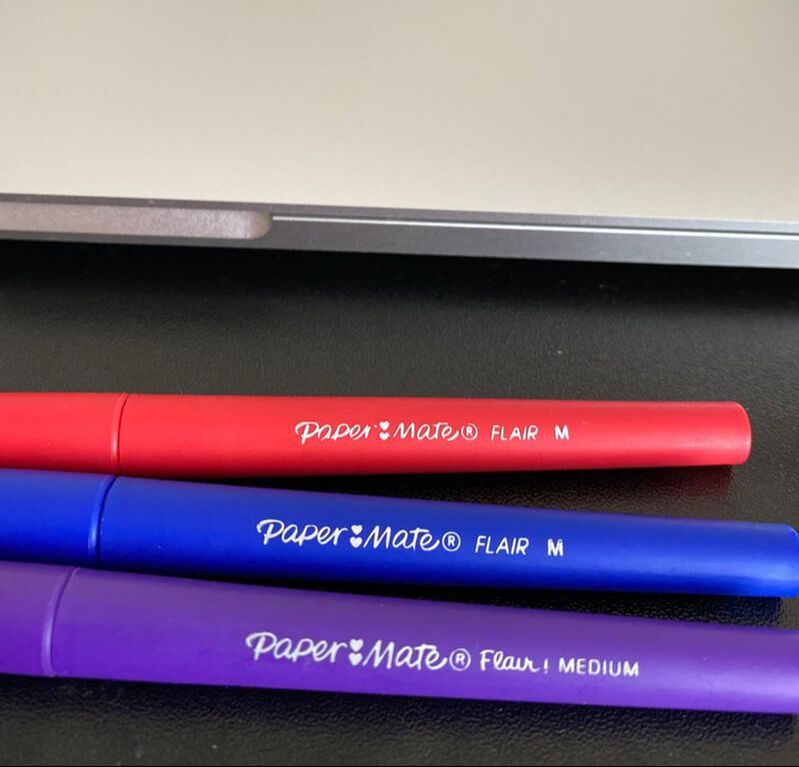
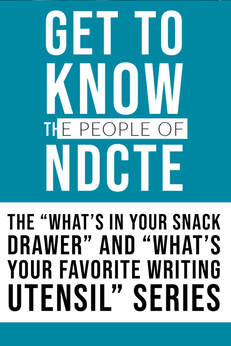
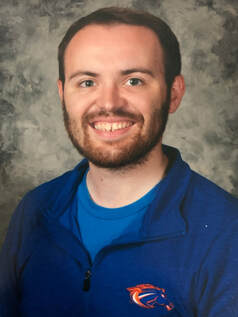



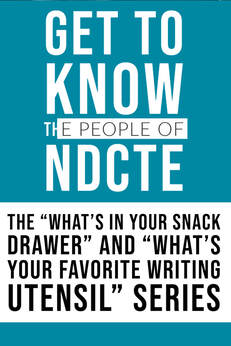

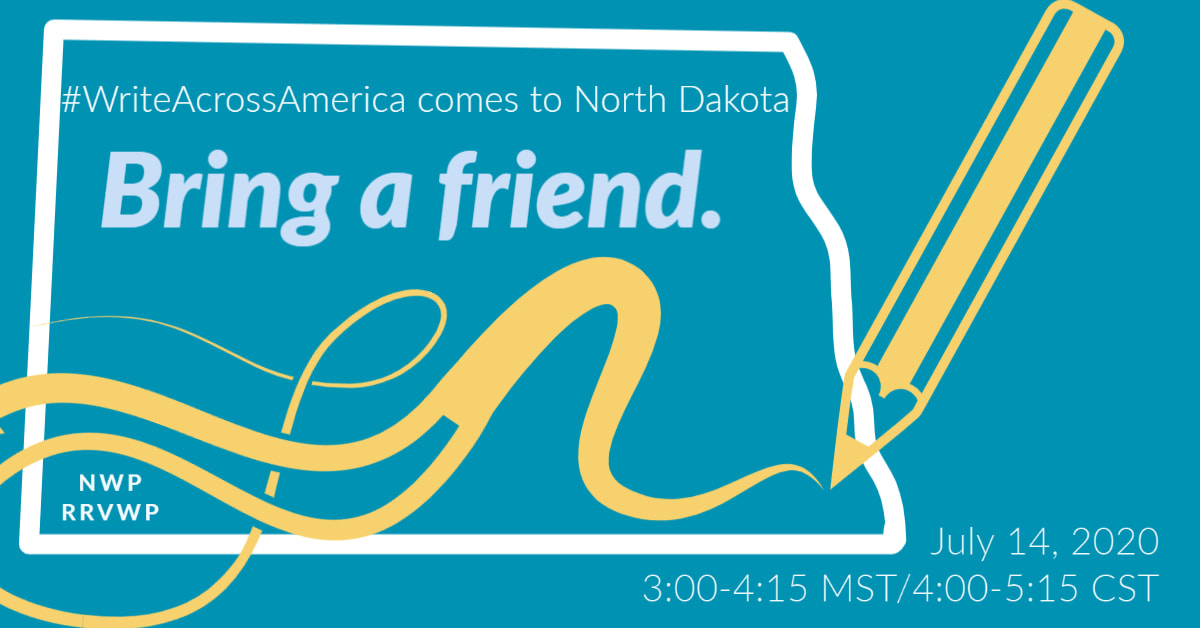
 RSS Feed
RSS Feed
